Content marketing may seem easy at a glance, but there is a lot that goes into it. Your writing needs to be strong, your topics need to be stellar, and your understanding of how to repurpose and utilize your best content needs to be solid. These are all distinct skills that are separate from the others but still necessary to achieve your content writing goals.
We discussed all this and more in last week’s #SEMrushchat, where we were joined by content marketing expert Brian Honigman. Brian is a content marketing and social media marketing specialist, a contributor at Forbes, and an adjunct professor at New York University; he had some incredible wisdom to share. He and our other chat participants had a lot of great input on how to improve your content writing to get your best results yet. Here is what they had to say:
Q1. If your goal is to get your article published on an external blog, how do you choose the right one and convince the editor to publish it?
One big goal many content marketers share is to get their writing not just on their own blogs, but on other big publications, too. While this may seem easy based on the sheer number of publications online, this is a lot harder than you might think. A lot of work will go into choosing the right publications to send your pitches or posts to, and you will have to show the editor that it will be a good fit.
When you are deciding which publication you want to submit your articles to, you want to weigh all the pros and cons when deciding between an industry-specific blog or a higher-profile, broader blog with a larger readership. High-profile, broad-interest blogs can definitely give you an edge in views and readers, and depending on the site, you could get a backlink which could benefit you more in terms of SEO. They may lend more credibility as a result. That being said, you may get more engaged readers if you publish on an industry-specific blog, which may better connect you with your target audience.
A1: For example, you’ll typically get more exposure amongst your niche on an industry blog, while a publication can drive new levels of credibility to your brand. #SEMrushchat
— Brian Honigman (@BrianHonigman) February 14, 2018
Compile a list of sites that will help you meet your goals. Make sure that they all have target audiences that you want to connect with, and that you can provide value to because it is a two-way street. Take into consideration things like blog tone and editorial guidelines (which many blogs that accept submissions often have on their site).
A1: It’s important to do your research when picking guest blog opportunities! You want to make sure the site has a similar target audience as you or an audience that you haven’t tapped into, but want to. #semrushchat
— Netvantage Marketing (@netvantage) February 14, 2018
A1: quality of published articles and audience is a big criterion. Then reach out via email and show that you can contribute to that quality. reference your best (published) articles and work you’ve done. Provide unique data/information. #semrushchat
— Kevin_Indig (@Kevin_Indig) February 14, 2018
A1: Never fly into an e-mail pitch. You will be relegated to the trash. Learn about outreach and what has worked for others. Lots of case studies out there.
Choose the right blog by being realistic. Do your research and accept Time probably wont accept a blind pitch #SEMrushchat
— Andy Drinkwater (@iqseo) February 14, 2018
A1: I’ll start with prospecting a list of blogs and I’ll add notes like blog tone, audience, niche market. When it comes to the person in charge, I’ll always write a person email and highlight their most recent post #semrushchat
— Danny Ray Lima (@dannyraylima) February 14, 2018
When it comes to pitching, a lot of it comes down to basic sense. First, make sure you are pitching the right editor. You would be surprised how often people get it wrong.
In your message, submit an idea for content that is valuable, suitable for their publication, and relevant. You only have a few sentences (think no more than four) to explain the pitch and convey why it could benefit their readership. You can benefit from highlighting either the topical, time-sensitive nature of the piece or how valuable the evergreen content would be. End with an introduction to you as the writer, including relevant experience or past publications that would prove your credibility. When doing this, follow all editorial guidelines carefully.
A1: Pitch Basics ➡️
1) Email the right editor
2) Share a relevant story idea concisely in a few sentences
3) Explain why the story matters
4) Introduce yourself with links to past pieces to showcase writing skills and credibility on the subject matter #SEMrushchat
— Brian Honigman (@BrianHonigman) February 14, 2018
a1 Choose to write an enchanting blog around a specific subject matter for which you KNOW inside & out. Present your blog concept to the publisher & let the blog’s value SHINE onto the target audience. #semrushchat
— Debi Norton (@BRAVOMedia1) February 14, 2018
A1 often publications have style guides – read them and also read a lot of their recent articles so you understand how and what they write about so you understand their true style and who they are aiming at. #SEMRushChat
— Simon Cox (@simoncox) February 14, 2018
A1. Ensure that the post you want to write will be relevant for the audience you’ll reach through the blog. When contacting the editor tell them, concisely, how your post can provide value #semrushchat
— Base Creative London (@basecreative) February 14, 2018
Cold pitching isn’t always the best approach; outreach may be more effective at helping you get your foot through the door. You can reach out to ask for a collaboration or ask if they need help with anything. In many cases, this could be met with radio silence, but it never hurts to try!
A1 – I use @SEMrush’s link building tool to find relevant links that are in our niche. I then simply write an email asking if they are interested in collaborating or publishing an article of mine. If you are genuine and a good fit, it isn’t that hard. #SEMrushchat
— Hilary St Jonn (@HilaryStJonn) February 14, 2018
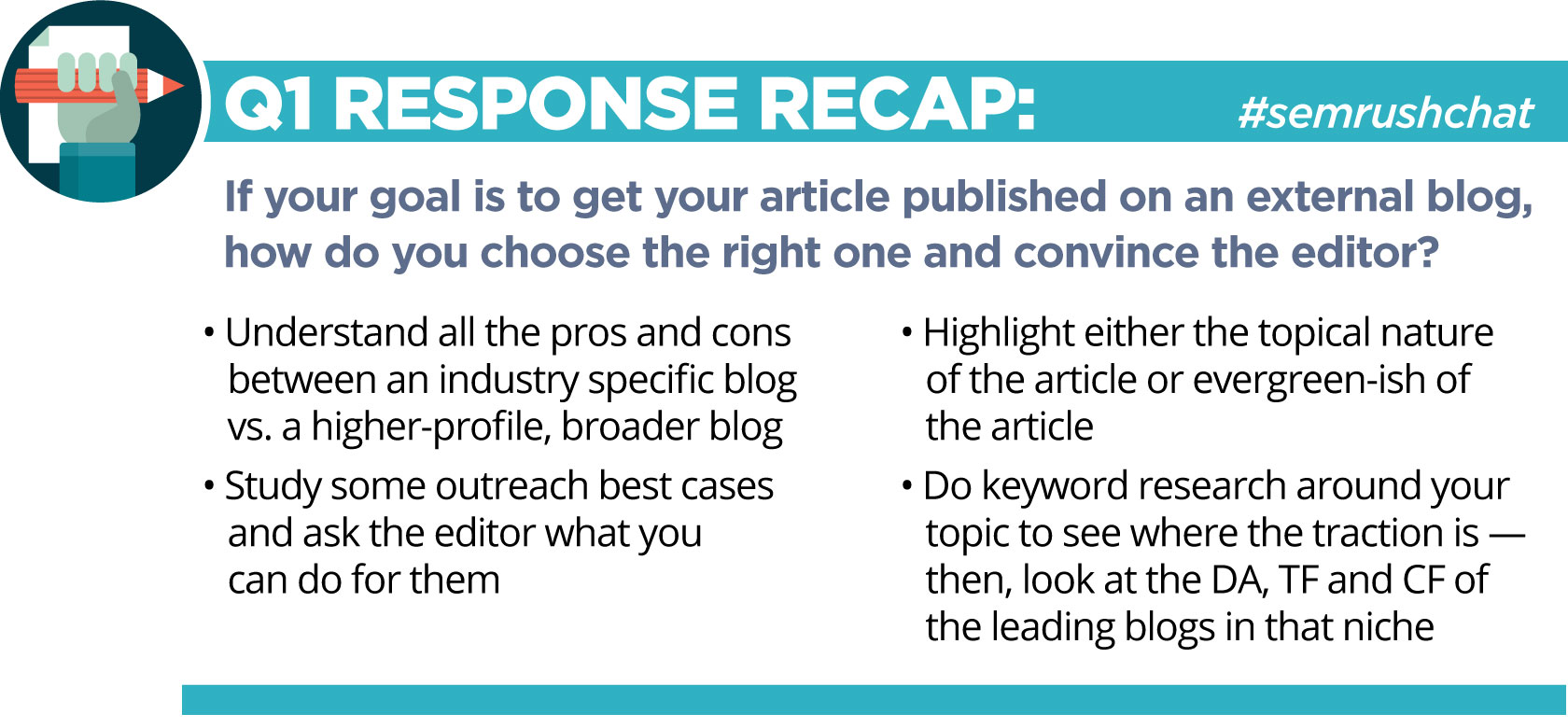
Q2. When it comes to writing an article, what are some of the tools/tricks you use to get ideas for useful and unique content?
Writing content that is both useful and unique will give you an edge, giving users a reason to come back to your site and share your posts more often than your competitors. Both of these factors provide the value that you want.
One of the best ways to write great content that’s both useful and unique is to write posts designed to answer questions that customers, colleagues, and industry peers have asked. This is a sure-fire way to provide value, and if they are asking these questions, it may be because they couldn’t find answers anywhere else. You can use Quora, Reddit, and Google’s auto-suggest to find some of these questions.
A2: use googles suggested searches to see what people are asking about. Browse twitter to identify trends of questions people have. The is not only useful & unique, but also in theory, timely. #SEMRushChat https://t.co/QUUSz93YEw
— Natalie Barreda (@nataliebarreda) February 14, 2018
A2. I steal ideas from my Facebook groups (which are little gold mines of info) I also use the inurl:forum + (keyword) to see what folks are talking about as well. I also look at what people are asking me in private messages. #semrushchat
— Doris Shadouh (@DShadouh) February 14, 2018
A2: 2. I also like to stay up-to-date with the competition. I’m subscribed to their newsletters and often check on what new topics are trending. Also, asking my audience what they like to read more about is important. #semrushchat
— Youness Bermime (@YounessBermime) February 14, 2018
A2: Ask your peers! Sometimes insight into what you’re writing needs to come from a 3rd-party. I also sometimes like an entirely different perspective (from someone outside the industry) since I can tend to miss the obvious since I’m “in the know.” #semrushchat https://t.co/KU9U8BhlqD
— ThinkSEM (@ThinkSEM) February 14, 2018
Twitter in and of itself is also one of a number of useful tools for content generation. Attend Twitter chats and see what people are saying; all the different interactions may spark something for you. You can also run Twitter polls to get ideas and to see what people are most interested in seeing.
A2. I run a Poll on Twitter which tends to generate some interesting topics #semrushchat
— Natasha Woodford (@TashaWoodford) February 14, 2018
A2. Try NOT to write about things you have no interest in. Articles are always better if you are actually enthused about the topic. Google alerts, Pinterest boards and Twitter hashtags provide plenty of ideas. #semrushchat
— Peak District SEO (@PeakDistrictSEO) February 14, 2018
A2:
Combing through social media to see what our audience talks about.
Looking at support tickets to know frequently-asked questions.
Observing topics and trends competitors are talking about.
Google trends and Keyword Planner to know which topics to cover. #SEMrushchat— Narmadhaa (@s_narmadhaa) February 14, 2018
Writing content that is timely and discusses what is happening in your industry at the moment or that ties in with recent events, like writing about This is Us in a post on fire safety– it can help you produce content that hasn’t been written yet. Sometimes we need that in order to create something truly unique.
A2: You want to always write about a mix of topics, some in response to what people are outright asking about and then some that are your own ideas entirely. You won’t break the mold only addressing what customers are asking for. #semrushchat
— Brian Honigman (@BrianHonigman) February 14, 2018
A2: #SemRushChat For ideas… They can come far and wide. A good general thing to see what’s in the news is to follow a @Flipboard mag on a topic. pic.twitter.com/1D3u05QcOT
— Colt Sebastian Taylor (@ColtSTaylor) February 14, 2018
A2: Keyword Research, trending topics, Google Analytics are all great ways to find topics that will drive traffic.
We just posted this infographic to help others generate relevant and unique content ideas https://t.co/ixs1yILo0q #semrushchat pic.twitter.com/AMJiXuZ3E0
— Smartly Done Websites (@SmartlyDoneWebs) February 14, 2018
Providing new and original data through your content also is exceptionally valuable. Think case studies or research reports. You can provide benchmark posts and statistics about your industry, or you can even experiment and test out new solutions to search for common challenges and how to address them. Assess the content you already have on your site with an audit and explore the gaps where you can produce relevant and insightful
When it comes to tools that you can use to find ideas and enhance great content, our chat participants mentioned SEMrush’s content analyzer, topic research, and keyword magic tools. You can also Buzzsumo, and Google’s “people also ask.”
A2: Identify and map out long-tail keywords. They are questions to answer. Use them when you plan your content & prioritise the post based on the data. Use underscore (_in) in @keywordtoolio to find them: _running shoes for_ and involve modifiers like e.g. _test_ #semrushchat
— Trond Lyngbø (@TrondLyngbo) February 14, 2018
A2: I try to find the fundamental questions around a topic and then create something new that hasn’t been done before. I love the new topic research module on SEMrush because it helps to find new relevant subtopics with ease. #semrushchat
— Kevin_Indig (@Kevin_Indig) February 14, 2018
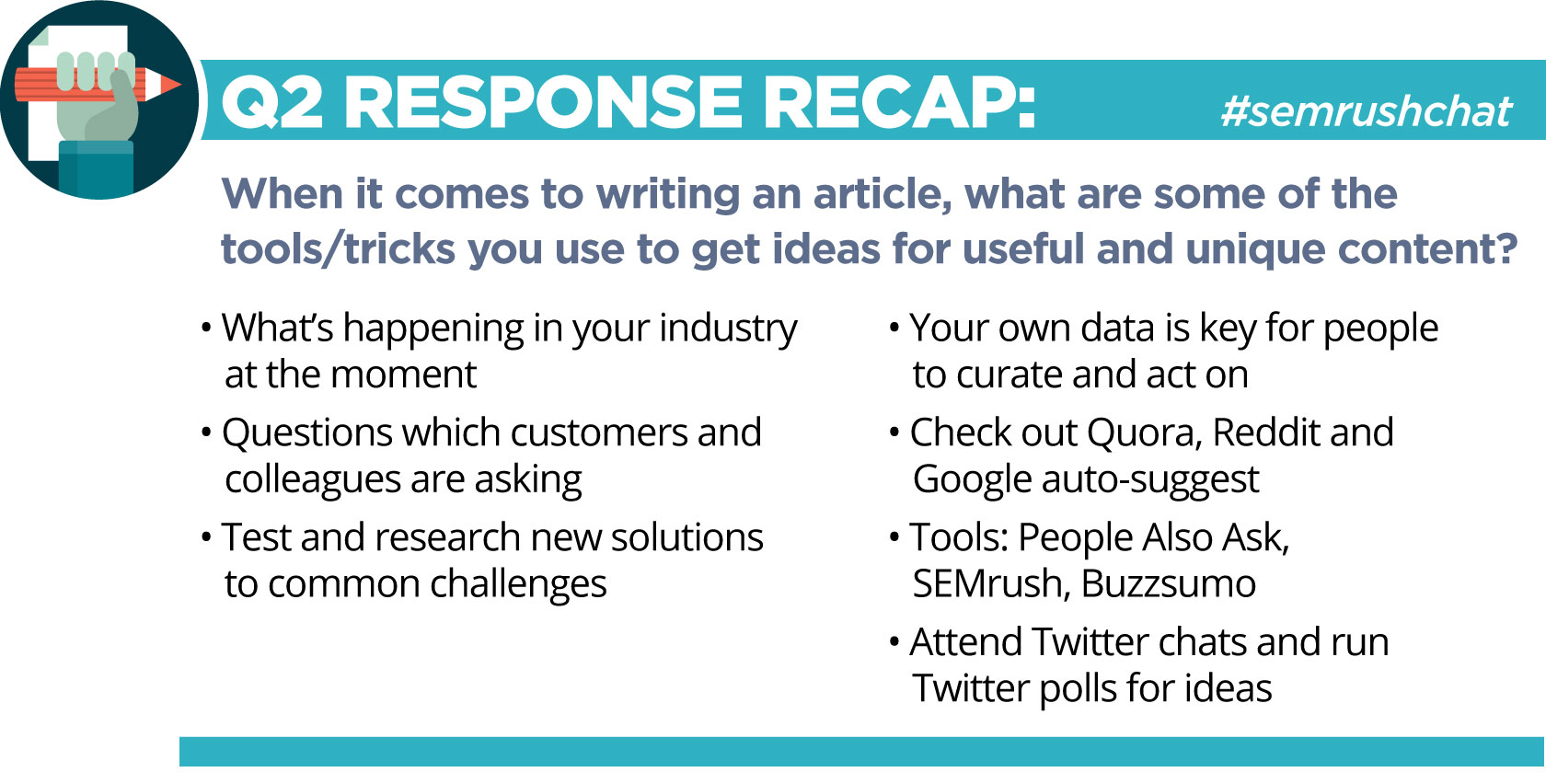
Q3. What are the best ways to repurpose an evergreen blog post?
Evergreen blog posts are great; they will stay valuable and relevant for a long period of time, and often continue to be shared and utilized as a resource. This will bring plenty of traffic to your blog. They also have the enormous benefit of being excellent to repurpose, giving you more bang for your content buck.
Turning blog posts into social media posts is one of the easiest ways to repurpose blog content. You can repurpose them into short Tweets or slightly longer LinkedIn posts. You can summarize the post, or offer additional thoughts that are still relevant to it.
A3: I’m a huge fan of syndicating my blog posts on various sites to ensure they drive more awareness amongst my audience. I recommend doing the same, but not just copying and pasting verbatim. Take some time to cater the post to the destination. #SEMrushchat
— Brian Honigman (@BrianHonigman) February 14, 2018
A3. You can Duplicate the post, change the title and the copy slightly, then post the whole thing on @LinkedIn or @Medium and link back to your site. Or for some posts, you can simply change the dates, to match current search terms. *This is my ‘Lazy’ hack answer. #semrushchat
— Peak District SEO (@PeakDistrictSEO) February 14, 2018
SlideShare is another excellent and popular option. You can include this with the article, and promote it separately. This will take a largely text-based article and turn it into something much more visual. SlideShare presentations are highly visual and digestible in their own way, making them an excellent tool to use when promoting and repurposing your content.
A3. Turn Visual content into pinterest boards.
PPTs to slidedeck via slide share. Something more than the usual repurposing. #SEMrushchat— Nehal More (@NehalMore) February 14, 2018
A3. ❤️ Micro content in the form of quotes shared on social media + link to blog
❤️ Use the quotes as slides & create a Slideshare presentation.
❤️ Video for YouTube + embed and add a transcript to your blog
❤️ Podcast #semrushchat— Virtuoso Assistant (@VirtuosoAssist) February 14, 2018
Another common strategy is to turn written content into a video, which can then be published on YouTube and/or shared natively on different social media platforms. Video often yields exceptionally high engagement rates on social media, so this is an excellent strategy to use. And if you want to go visual but don’t want to go all out on video, you can opt for an infographic representation instead.
A3: You can actually re-purpose your evergreen blog post in multiple formats for multiple platforms:
1. Short video
2. Infographic
3. Slideshare
4. GIF
5. PDF Guide
6. Multiple Images #SEMRushChat— Ayesha Ambreen (@AyeshaAmbreen) February 14, 2018
A3: Most common are turn them into infographics and video format. The lesser known are podcasts and SlideShare presentations. Also, never hurts to break the post into an email course/newsletter for free (if it is possible) #semrushchat
— Youness Bermime (@YounessBermime) February 14, 2018
A3 I like creating infographics, and breaking those up into smaller graphics for social media, and then creating videos. #SEMrushchat
— Hilary St Jonn (@HilaryStJonn) February 14, 2018
A3: VIDEO!!!! They’re fun to make, and the script practically – literally! – writes itself. #SEMrushchat pic.twitter.com/rZRKXe5xdT
— SumAll (@SumAll) February 14, 2018
You can also use one great evergreen piece to jump-start more great content. If you set up a Google Alert on your topic, for example, you can update your post with the new relevant info and repromote it. You could also launch a series of similar posts on the same topic.
A3: If you invested a considerable amount of effort into an evergreen blog post, try making it the centerpiece of a content marketing campaign! #SEMrushchat
— Volume Nine (@volumenine) February 14, 2018
A3: #SemRushChat If you have a bunch of articles talking about similar things, make a “Top 10” list with links to previous blogs. pic.twitter.com/kWmESrVBsl
— Colt Sebastian Taylor (@ColtSTaylor) February 14, 2018
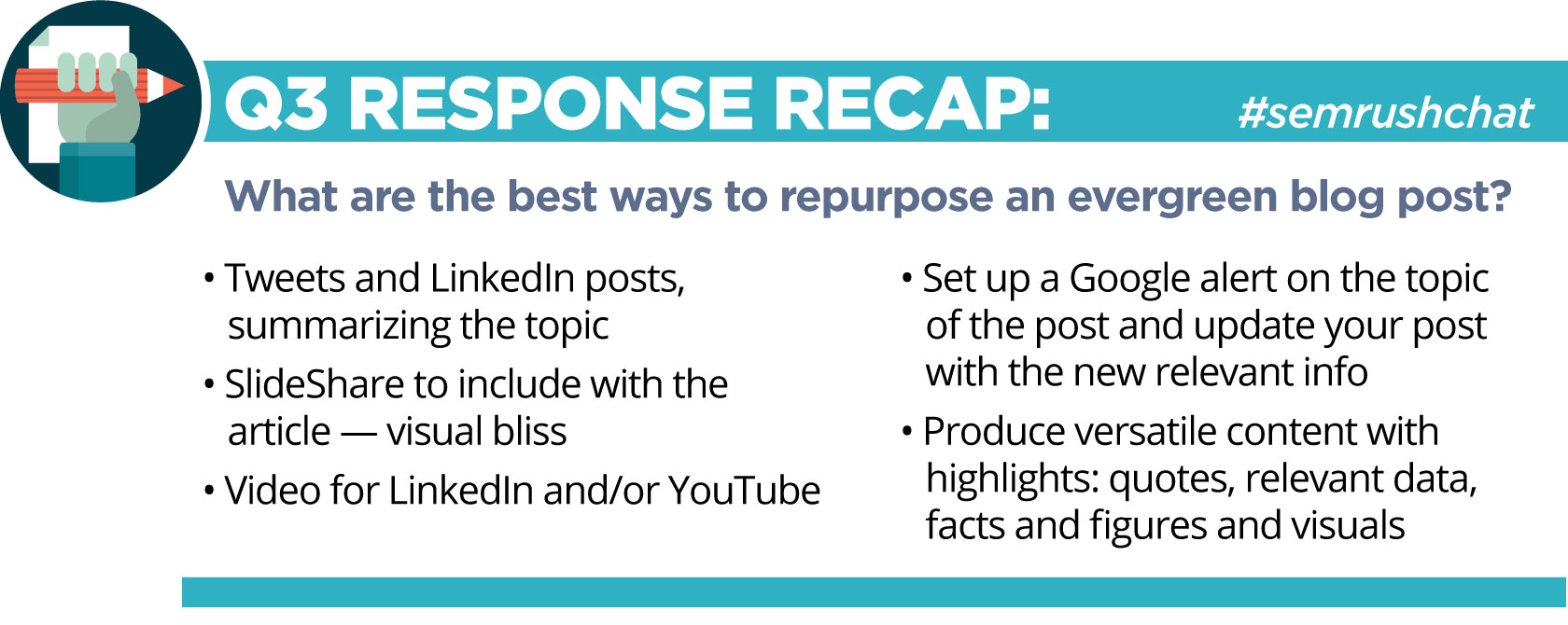
Ultimately, the more valuable and shareable you make your content, the easier it will be to repurpose. Versatile content would include quotable snippets of text, data, statistics, and some great visuals. All of these elements can be repurposed separately or together.
Q4. What are some of the most unusual ways someone could distribute their content?
A lot of emphases is placed on creating and publishing your content. Distribution, however, can matter just as much, and this is an area that a lot of content marketers will fall short. Because of this, we asked our chat participants about new, innovative ways writers can distribute their content and get it in front of their audience. These should be used in addition to your conventional distribution methods, which your readers may come to expect to hear from you through.
A4 If your audience has an expectation that you will use specific channels to reach them, use those consistently and reliable. You will likely have better results than trying to be novel. #SEMRushChat
— Bill Slawski ⚓ (@bill_slawski) February 14, 2018
Brian Honigman reminded us that nothing can be as effective as authenticity, and informed us that training your employees to distribute content authentically and naturally is a great way to distribute your content more effectively. They can share it on social media, or send it to your clients that they have relationships with, for example. Because these sharings will come from your employees and not a marketing bot, readers will automatically pay more attention.
A4: Train your employees on the best & most *authentic* ways to promote your company’s content across social media and their network. Like teaching them how to email a relevant blog post to a colleague or share a brief summary of an article within a LinkedIn post. #SEMrushchat
— Brian Honigman (@BrianHonigman) February 14, 2018
Other chat participants agreed about the unconventional use of social media and messaging tools in new ways to distribute content. Instagram Stories, for example, could work well if you have the ability to embed a “Swipe up to see more” link.
A4: Following are some content distribution ideas:
1. Instagram/Snapchat Stories (with embedded link)
2. LinkedIn Pulse (Link back to the original post)
3. Medium (Visuals/Summary)
4. Responsive Emails
5. Chatbots #SEMRushChat— Ayesha Ambreen (@AyeshaAmbreen) February 14, 2018
A4: Instagram Stories! I didn’t know about this until I read this @CMIContent article. Haven’t tried it yet, but boy, this is awesome. Check it out, folk: https://t.co/vxXxubDn9o #SEMrushchat
— Narmadhaa (@s_narmadhaa) February 14, 2018
Whatsapp, messenger, and slack could also help distribute your content to people within your network in a more personal and direct way, increasing the likelihood that they’d see it. With the messaging app distribution method, though, make sure you don’t end up spamming people by sending them content (and nothing else) too often.
A4. utilising chatbots or distributing content through Amazon Echo / Google home #SEMrushchat pic.twitter.com/NR92sUoaGN
— clockworkTalent. (@clockworkTalent) February 14, 2018
A4. I share my updates in my coms channels as well using normal web methods, Messenger, Whatsapp, Slack etc. You can also grow your audience with quote cards inside product deliveries. Quotes on stickers. #semrushchat
— Peak District SEO (@PeakDistrictSEO) February 14, 2018
Some businesses also republish their blog posts on Medium, which puts them in front of an instant viewership on a site that is designed to generate shares and discussion.
A4 (2): I’ve also become a fan of repurposing on Slide Share. I know it’s not the shiny new thing, but there’s something valuable and re-usable about a presentation.
Also, curating/repurposing a post on LinkedIn Publishing or Medium. #SEMrushchat— Narmadhaa (@s_narmadhaa) February 14, 2018
One chat participant mentioned the idea of creating an audiogram. Audiograms are trailers that visualize audio clips that were pulled from a much longer piece of content, and they can be shared on video-crazy social media to entice users to read more.
A4: I don’t why I stopped, but I loved using @LumenFive to create short videos for the articles I wrote. Last time I checked the tool was in Beta mode. but that was a cool way of spreading the word about the content. #semrushchat
— Youness Bermime (@YounessBermime) February 14, 2018
There is also a pretty old school method one chat participant mentioned that we love: just picking up the phone and reaching out to local businesses and organizations directly. You can inform them about what your business does, and direct them to free resources that you have online on your blog, especially if you have extensive guides, free ebooks, or case studies.
A4. Sad that it’s unusual, but picking up the phone! If you’re looking to distribute to local orgs/businesses/etc., this goes a long way in humanizing yourself as a content marketer and ensuring your message is heard. #semrushchat
— Postali (@Postali) February 14, 2018
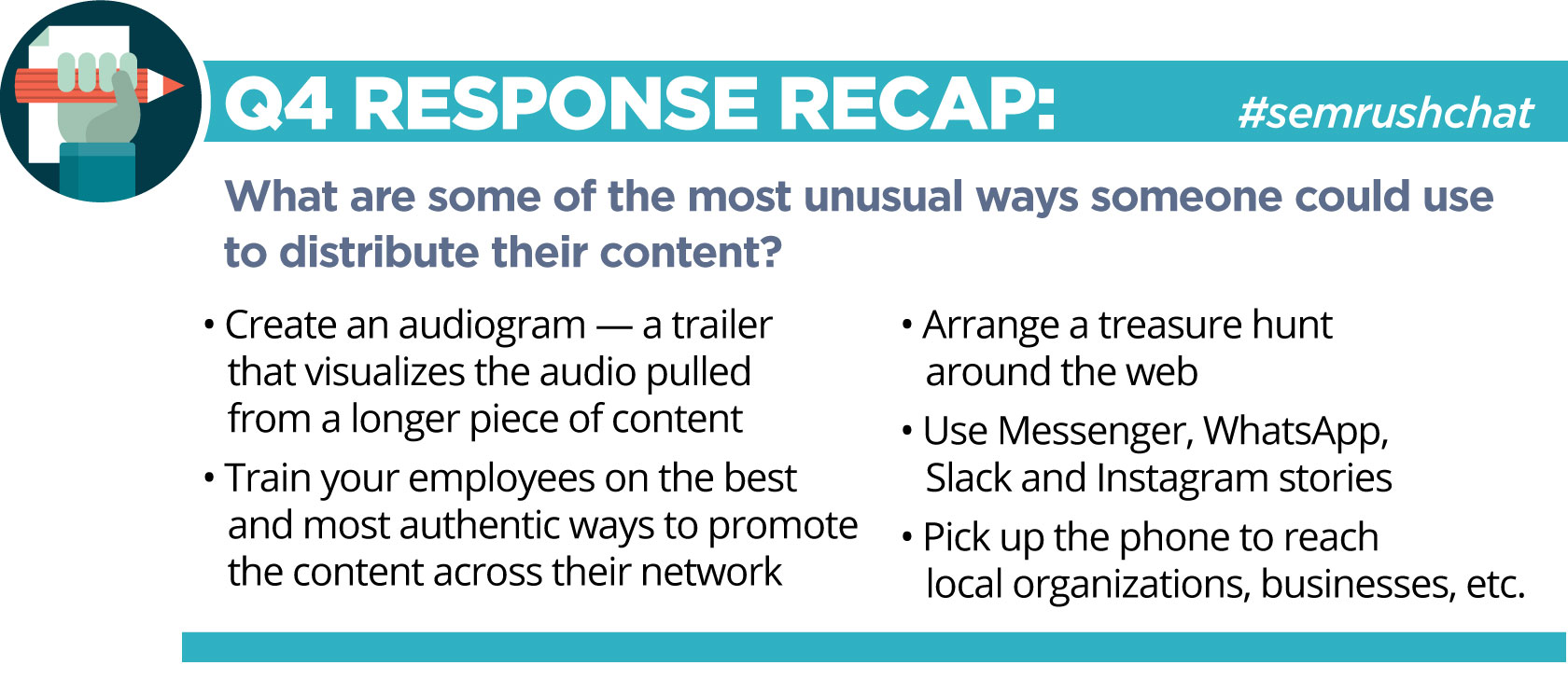
Q5. What are some of your favorite books, resources, or online courses you could suggest in order for someone to refine their writing style?
What you choose to write about will determine whether you get shares, but in many cases, your writing style can affect whether or not people even read past the first paragraph. Strong grammar and well-written posts will make you seem more credible and are easier for your viewers to read, while writing in an SEO-friendly manner, will help boost your organic readership.
There are several great books that can help writers improve their writing. Ann Handley’s “ Everybody Writes” goes over strategies to improve your writing, and even includes basic grammar lessons and elements of storytelling.
A5: Resources that have helped me improve my writing: the straight-forward advice found in @annhandley‘s book Everybody Writes ( https://t.co/Vqd2Syj5ML) and reading @shanesnow articles ( https://t.co/0Uu7sZNwcb) to learn how to write more clearly and concisely. #SEMrushchat
— Brian Honigman (@BrianHonigman) February 14, 2018
A5- Everybody Writes by Ann Handley is great to have to hand #SemrushChat
— Suze Cooper ✨ (@minicoopersmum) February 14, 2018
A5: no resources to post. However, if you’re debating on fixing your technical style or fixing your storytelling style, always pick storytelling. Technical errors can be caught by editors, but if you’re not an engaging storyteller, technical aptitude doesn’t matter #SEMrushchat
— Natalie Barreda (@nataliebarreda) February 14, 2018
“ The Elements of Style” by Strunk & White is another popular one, which goes through writing styles (including things like grammar and sentence structure) in a witty, entertaining way.
Horror extraordinaire Stephen King even has a book on writing that many would find useful, which is aptly titled “ On Writing: A Memoir of the Craft.” This book focuses mostly on the habits that King uses while writing, but it can still give insight to writers who want to produce mass amounts of content.
A5: I still haven’t had the time to check these thoroughly but they seem interesting (not too web content related, though)
Bird by Bird — Anne Lamott
On Writing — Steven King
Page After Page — Heather Sellers
Big Magic — Elizabeth Gilbert #semrushchat— Youness Bermime (@YounessBermime) February 14, 2018
There are a number of different online courses that you can take online that go over different aspects of writing style. Some that focus on content marketing includes those from Hubspot and CoSchedule. You can also check out your favorite marketing blogs, which occasionally have free and reliable articles on how to improve your content writing.
A5: I huge fan of the AP Style writing book, @copyblogger, @CMIContent @Grammarly, @GrammarGirl, and Hey Mr. Whipple, Squeeze This. #SEMrushchat
— Danny Ray Lima (@dannyraylima) February 14, 2018
A5. This is an interesting piece of content on content writing tips: https://t.co/FKuYsMPDEr #SEMrushchat
— Praveen Sharma (@i_praveensharma) February 14, 2018
While utilizing professional resources like those discussed above is something that all content writers should absolutely do if they don’t have a formal education in writing already, you shouldn’t just stop there. You can also check out what other writers you admire are doing, especially those in your industry. Read their work, and pick apart what you like about their content and how they write it. Then, adapt what they do to your content strategies and make it your own.
A5: To improve your writing I recommend following other writers you admire in & out of your industry, consistently reading their work & adapting what they do to your own approach to writing. Look for inspiration on to grow as a writer, not things to copy outright. #SEMrushchat
— Brian Honigman (@BrianHonigman) February 14, 2018
A5) I always say, read and understand writers you like. What are they doing? How is it structured? Learn to edit your work. Use @grammarly to tidy up your grammar and allow you to focus on what you’re writing.
And get lots of critiques. #SEMrushchat
— David Rosam (@davidrosam) February 14, 2018
A5 (b):
• Nicely Said: Writing for the Web with Style and Purpose—because everyone should read that.
• Modern fiction for some creative inspiration.
• Random articles from non-related industries so we don’t get used to too much of our own jargon. #SEMrushchat— Narmadhaa (@s_narmadhaa) February 14, 2018
A5. You can be the best writer, but you really need to understand the industry you’re writing about in order to refine it in the best way. Read through the most authoritative/relevant industry-specific blogs so you understand the language and style norms. #semrushchat
— Postali (@Postali) February 14, 2018
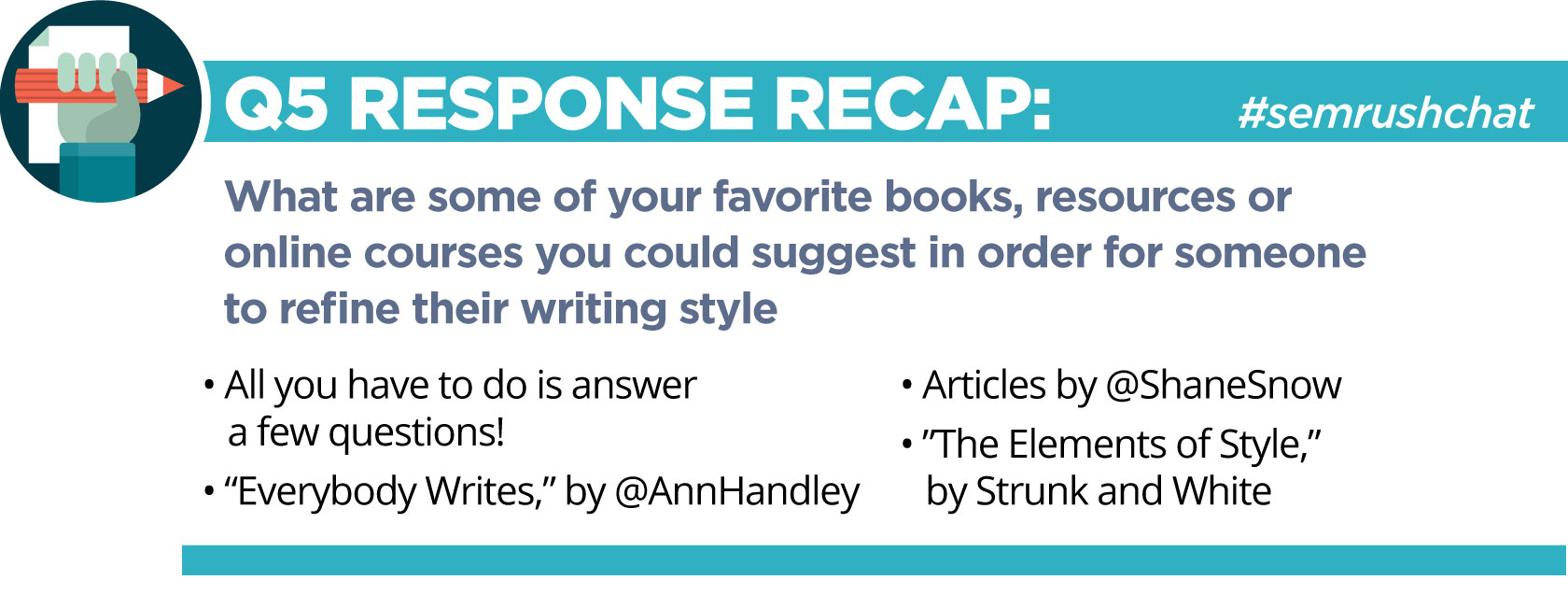
That’s all for today! Make sure to join us this week on #SEMrushchat as we answer “What Makes a Good SEO Strategy?” with special guest, Sam McRoberts!